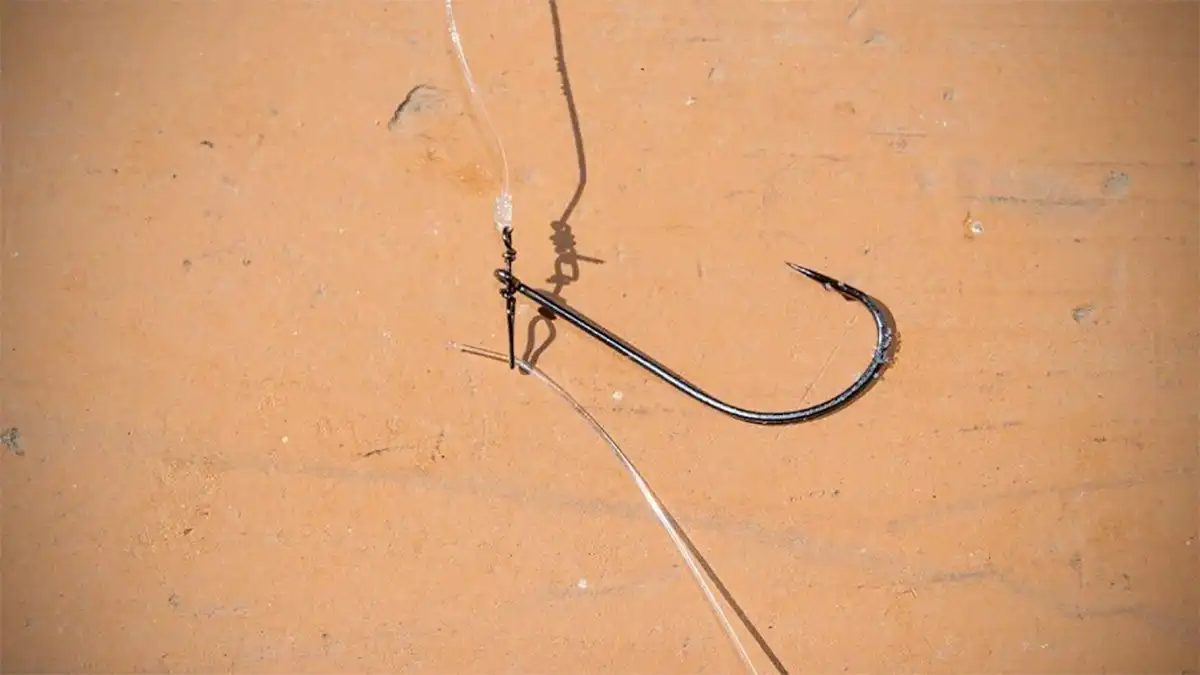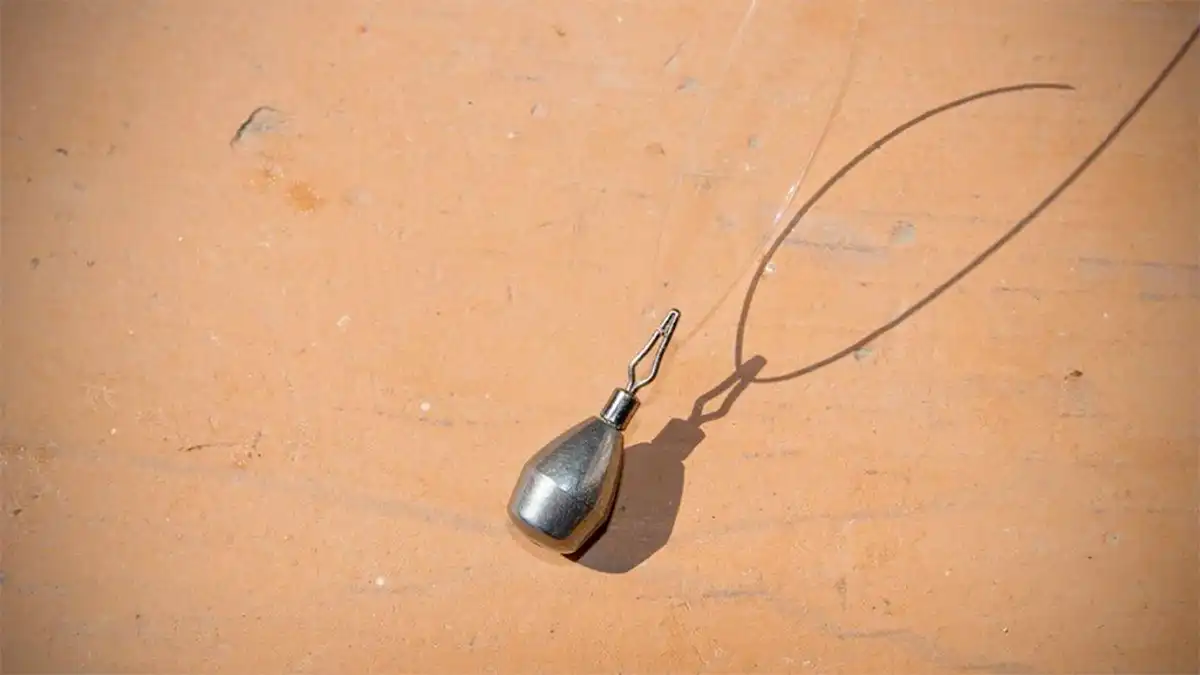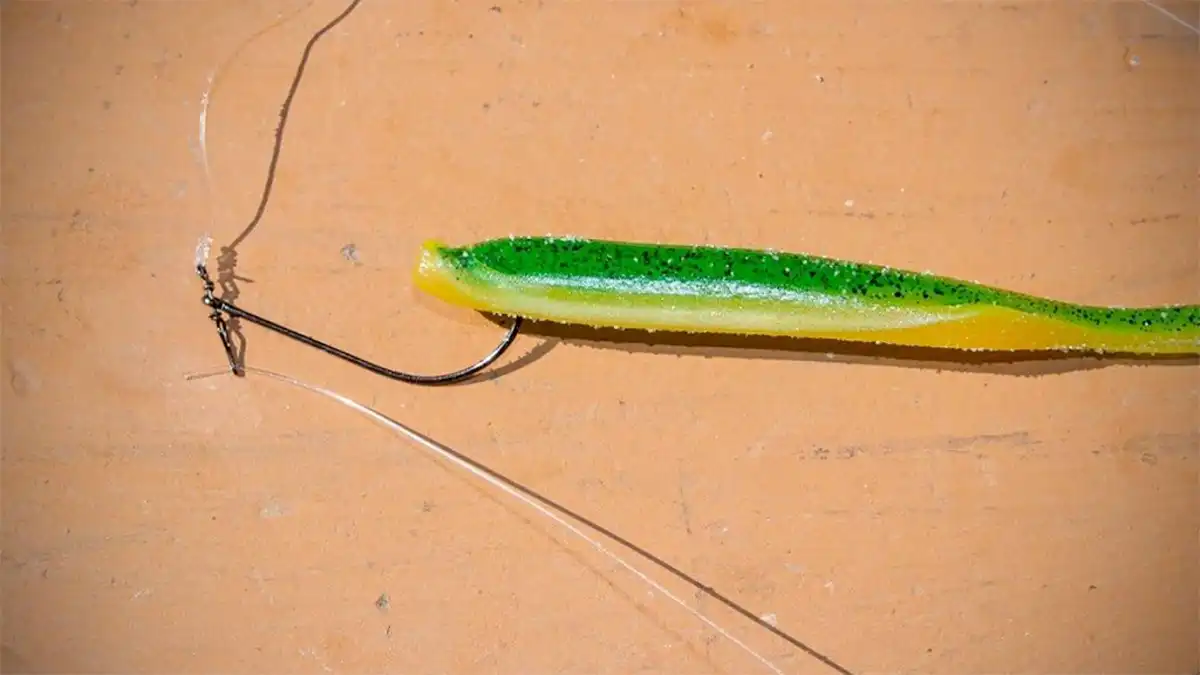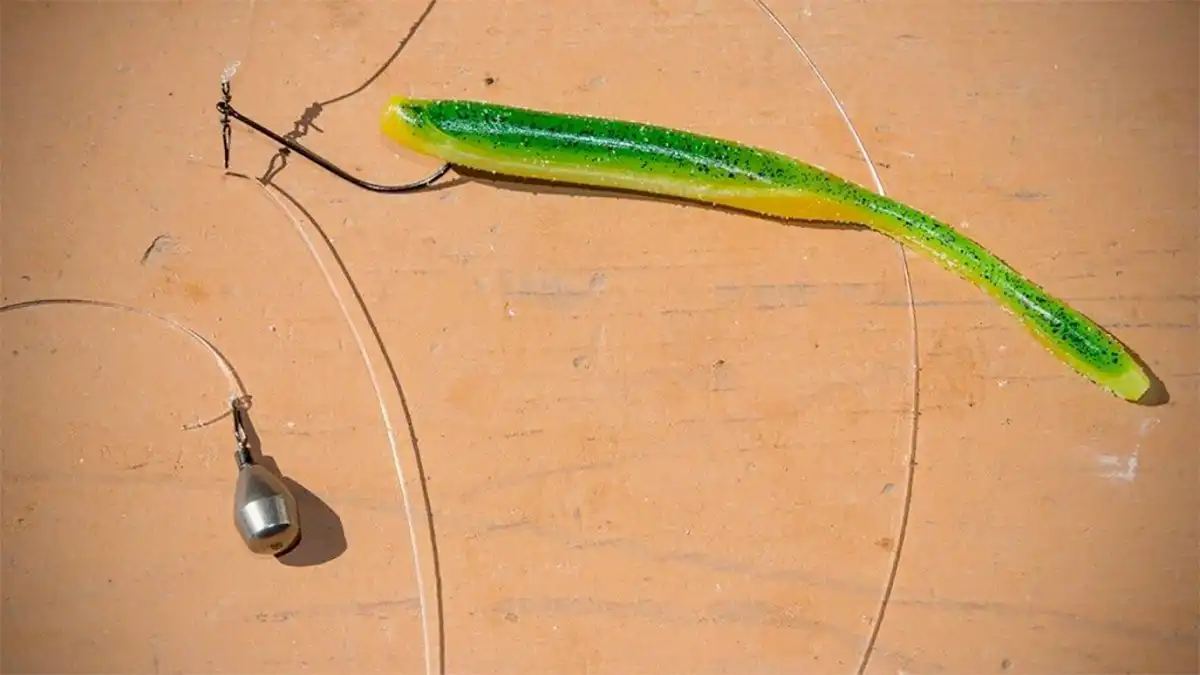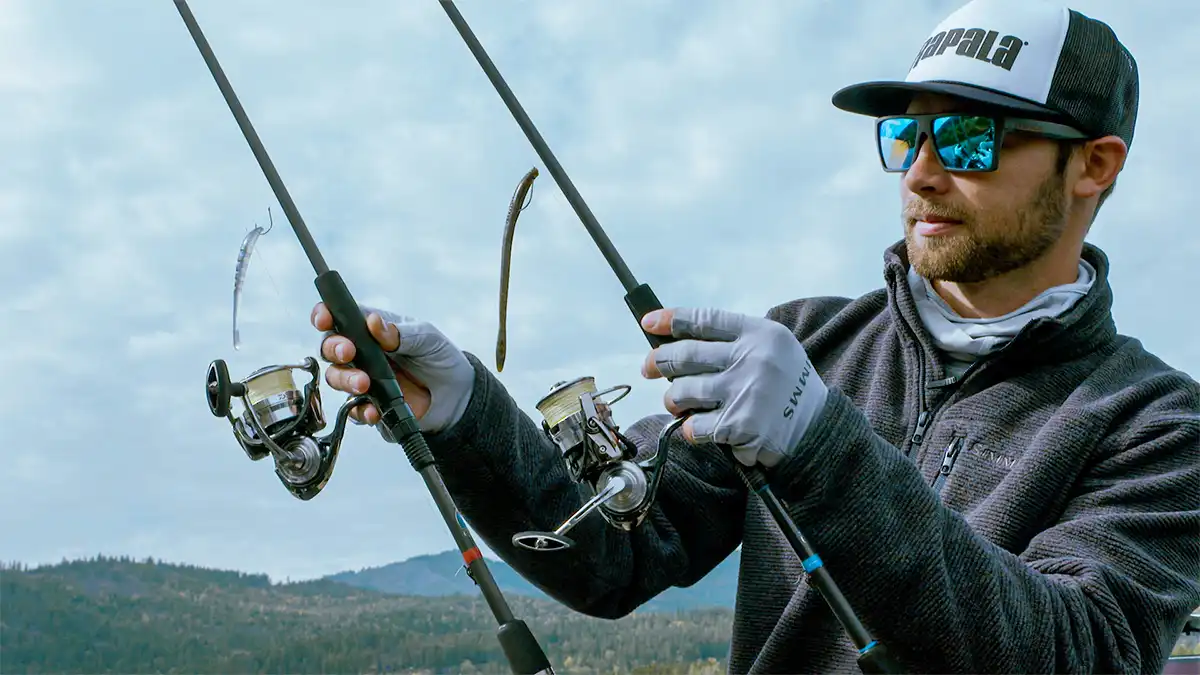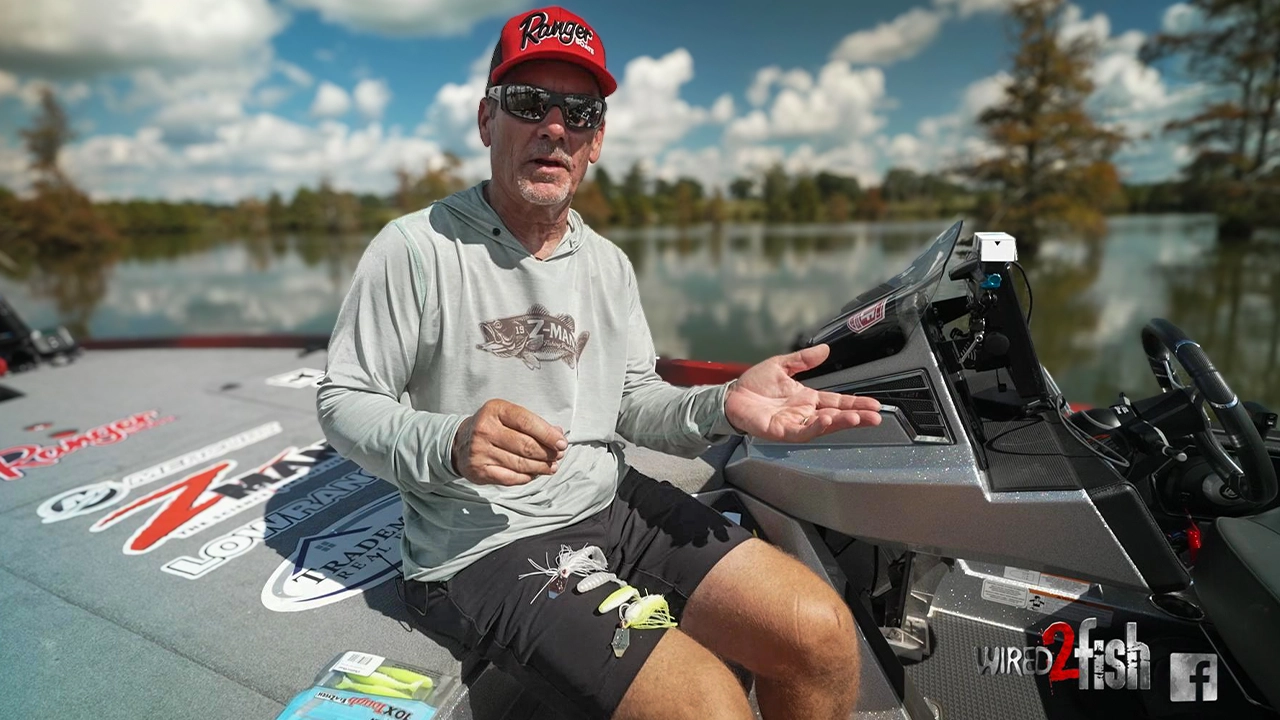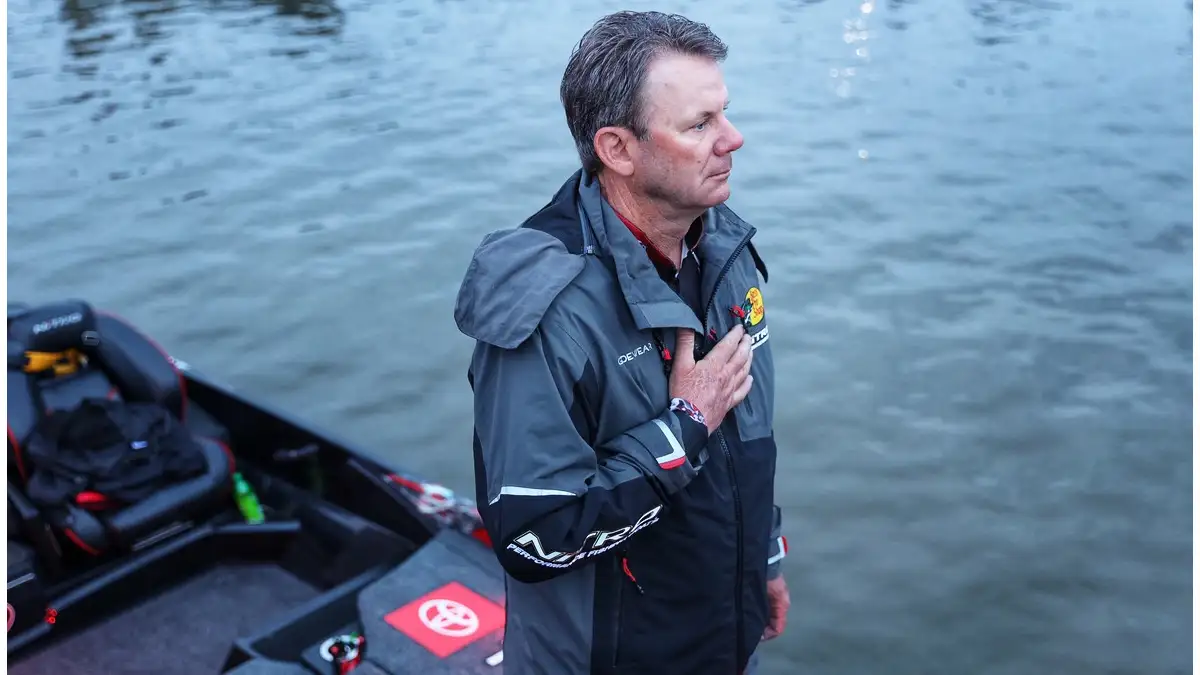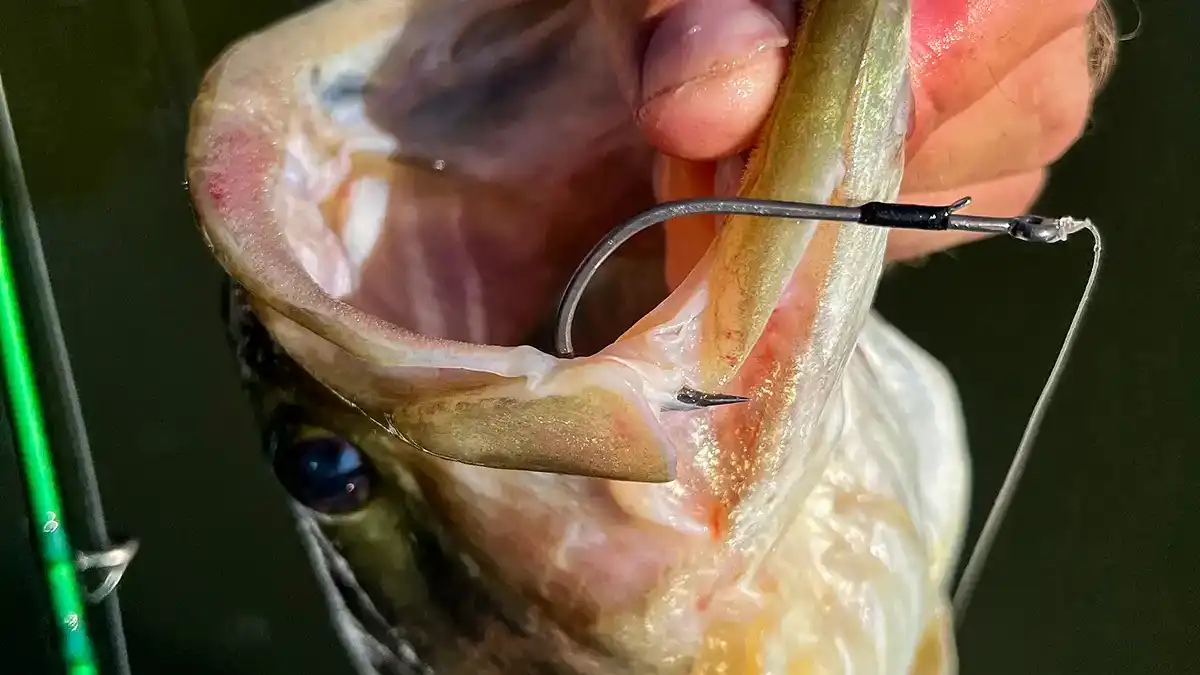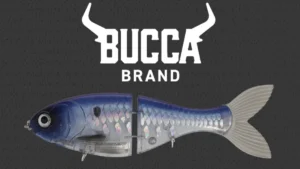A bass fishing drop shot rig allows your bait to suspend several inches over the lake bottom while being anchored by a weight. Used for many years by finesse anglers, this particular rig does an excellent job at enticing finicky fish to bite in difficult conditions. Its natural presentation excels at making fish bite in a wide variety of scenarios.
What is a drop shot rig
A drop shot rig is essentially a line tied to a hook with a leader underneath, so the bait hovers off the bottom and creates a very natural, realistic presentation. This rig is especially effective in clear- or deep-water situations when it might be tough to get a bite from otherwise wary fish.
As the angler drags the weight across the bottom, the a normally nose-hooked worm dances a few inches above and creates an outstanding presentation for spooky fish. Even with the slightest movement of the rod tip, the angler can incorporate a lot of movement into the soft-plastic worm and get bites.
Drop shot rig setup
For the large majority of bass fishing situations, the drop shot is fished on a spinning rod and spinning reel. Casting gear can occasionally be used in particular situations but you’re going to be using finesse gear for the large majority of your drop-shotting situations.
As a good base setup, a 7-foot, medium-light action spinning rod is a great place to start. If you’re dropping vertically on fish around small targets, a shorter 6-foot, 6-inch rod might be advantageous as you can more accurately drop your bait on isolated cover.
As long as it has a sensitive tip, you should be just fine. A spinning reel spooled with 6- or 8-pound fluorocarbon fishing line is preferred by most anglers. For added sensitivity throughout the retrieve, many anglers prefer to use 15- or 20-pound test braided line as a main line, attached to a 4- to 6-foot fluroocarbon leader due to the low-stretch qualities of braided line. Unlike fluorocarbon and monofilament, braided line is much more rigid and the lack of stretch transmits bites to the rod blank and angler much quicker, often resulting in a higher hookup ratio for the angler.
How to tie a drop shot
Tying a drop shot takes a little practice but after a few times, it gets much easier and becomes second nature to the angler. We’ll go step-by-step to help you understand the process.
Step 1: Tie a hook up the line
The drop shot features a hook up the line with either a leader or long tag end to attach a weight at the bottom. New drop shot hooks feature swivels and can make rigging a little easier and more streamlined. We will usually tie a hook onto the line with a 12 to 18-inch tag end. We then feed the tag end back through the eye of the hook on the top where the point is facing up and run it out the bottom to make the hook stand out straight on the line.
Step 2: Add a weight to the bottom
Add a weight to the bottom of the line. Either tie on a typical bell weight or use a specific drop shot weight with a clip.
We will tie a knot in the end of the line, even with the quick clips on most drop shot weights. The weight stays on fine either way while fishing, but when you are fighting a fish and they jump, they will often throw the drop shot weight off if it’s not tied to the bottom of the rig.
Step 3: Nose hook or Texas rig the plastics
Add the worm to the hook, with either an under-the-chin and out-the-nose orientation or you can even Texas rig it onto the hook.
Light-wire hooks are often better with a drop shot rig. Light line in deep water with smaller guage wire will penetrate a little better. Hooks with small keepers will hold a Texas-rigged plastic are also preferred. Most of the time, we nose-hook our soft plastics when drop shotting, but will switch to Texas rigged around cover.
Step 4: Vary weights and leader lengths
The drop shot, much like the Carolina rig, can be modified with longer leaders between the worm and the weight and with heavier and lighter weights. Generally we try to use the lightest weight we can and still feel the lure and bottom for a more natural presentation. Most of the time we start with 1/4-ounce, but we’ve fished as heavy as 1/2-ounce and as light as 1/16-ounce. There are tons of great plastics now for drop shot fishing, so color and profile options are endless.
You can pendulum a drop shot through suspending fish by using a very light weight, such as a 1/16-ounce. It’s also effective fished vertically off the bottom for suspended fish you see on your electronics.
How to Drop Shot for Bass
Many of the top professional bass anglers keep a drop shot rigged and ready at all times throughout the entire year. Although it excels in clear water, it can also work very well in dingy water if you use a dark-colored soft plastic.
When the fishing gets tough and the fish get a lot of pressure, a drop shot shines. It gives the fish a different look and you’re able to fish it in one foot of water to 100 feet of water. It truly is a do-all rig that will put fish in the boat whether you’re fishing from a boat or from the shoreline.
Another situation in which the drop shot rig shines is when you’re fishing around a slimy or muck-covered bottom. A lot of times, whether it’s a big lake or a small pond, the bottom composition can be really nasty and foul up other bottom-contact presentations. So for instance, a Texas rig or Carolina rig won’t come through the nasty stuff very well because the bait itself is dragging along the bottom.
The drop shot, however, allows you to keep your soft plastic and hook above any impediments along the bottom of the lake or pond, which does two very important things: The bass can see your lure easier and you can feel bites with ease. Drop shot fishing isn’t very difficult and it can be effective for any angler, regardless of their experience level. You can both cast a drop shot and work it back towards you and if you’re in a boat, you can drop a drop shot vertically to the bottom and “jig” it to fool bass that are suspended off the bottom.
When you’re fishing a drop shot, it’s important to focus on moving the soft-plastic bait more so than the weight. The whole key to the drop shot rig is the freedom of movement it offers the soft plastic. So instead of dragging it all around the lake bottom and making a big ruckus, a few very light shakes of your rod tip will impart all of the necessary action into your soft plastic. This comes across as a very natural presentation to the fish which, of course, increases your chances of fooling a big one.
Drop shot hooks to get better landing percentage
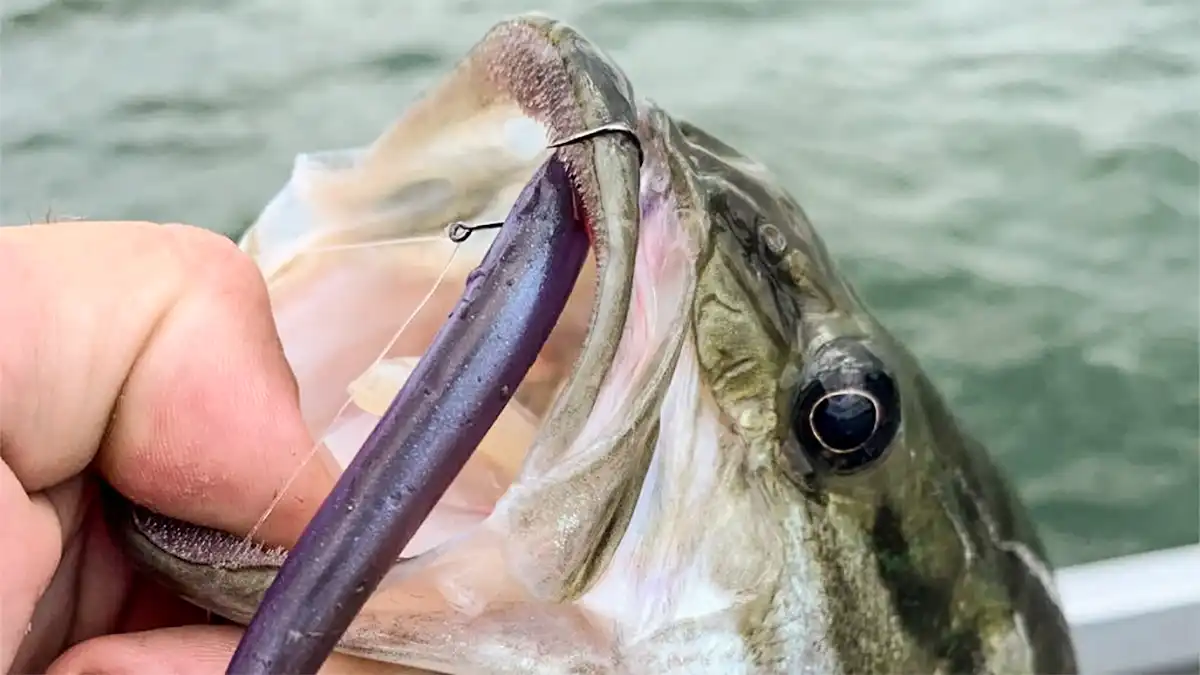
Drop shot hook selection doesn’t need to be overly complicated. If you’re just getting started with the technique, you have a wide variety from which to choose. We recommend choosing a split shot or drop shot hook in the No. 1-1/0 size range. These particular hooks aren’t made for heavy-line, close-quarters fishing; they’re specifically made for drop-shotting. They will have thin wire which is best utilized with the aforementioned pound-test lines.
As an important side note, because you’re using light-wire hooks, you do not need to set the hook too hard when you get a bite. An upwards, reeling-type hookset is often the best choice because if you set the hook too hard with these dainty hooks, it can cause bending or warping which will allow the fish to escape.
Here are some drop shot hooks we have reviewed and recommend:
Drop shot weights for various applications
Drop shot weights are much different than most of the traditional weights we use in bass fishing. The large majority of these weights feature a crimped swivel at the top that allows you to easily attach the weight to the elongated leader below your hook. It’s easy to become overwhelmed when you’re choosing a particular size weight for drop-shotting but as a general rule, it’s a good idea to start with a 1/4-ounce or 1/8-ounce weight.
Of course, the deeper the water, the heavier weight you’ll want to use. Also worth noting is the wind conditions because a stiff wind will put a prominent bow in your line which will significantly decrease your sensitivity throughout the retrieve, even if you’re using a low-stretch braided line. So if you find yourself fishing in breezy conditions, don’t be afraid to upsize that drop shot weight to increase your sensitivity a little more.
You’ll also notice a choice between plain lead and painted drop shot weights. Although it’s largely a personal choice for anglers, many believe the black-colored weights blend in with the lake bottom a bit better, therefore increasing both stealth and the number of bites. Don’t think that has to be the rule, however, as regular plain lead weights have worked for decades and will continue to produce consistent fish catches.
The shape of the weight can also have ramifications. You’ll find all kinds of choices ranging from cylindrical-, round- and bell-shaped weights for drop shot fishing. The cylindrical weights tend to be more stealthy throughout the retrieve but they’re also prone to snagging in small crevices, especially rocks. Round weights are more of a base-level option, meaning they’re quite versatile. They may not have the appeal of the more uniquely shaped weights but they’re a solid option for a wide variety of scenarios. The bell-shaped weights seem to be the best for fishing in and around rocks.
Drop shot rods to increase your odds
Drop shot rods are an important element of this system. As mentioned earlier, a 7-foot, medium light-action rod is an outstanding starting point. A lightweight rod is preferred by most anglers but remember, the lighter the rod, the higher the price point. So if you’re just starting to experiment with the drop shot technique, it’s not always necessary to get the most expensive rod you can find. Thanks to advancements in technology, you can find some mighty fine drop shot rods in the $120 to $150 price point.
If you’re a boater and like to watch your electronics in order to vertically drop on fish, a shorter rod is pretty popular for that technique because it reduces the pendulum effect as you drop your drop shot weight and bait to the bottom. We don’t go much shorter than a 6-foot, 6-inch spinning rod for this particular technique and of course, we still stick with a medium-light action.
Drop shot baits that are proven winners
Drop shot baits aren’t as complicated as many anglers might think. Because this is largely a finesse technique meant for clear water and subsequently skittish bass, the preferred baits tend to be very streamlined and honestly, somewhat unexciting. In the large majority of situations, you’re not going to be dealing with baits with a bunch of large, water-displacing appendages. Quite the contrary, actually.
The more streamlined, or finesse, the better when it comes to this bass fishing technique. You’ll find a lot of options out there on the market but if it’s smaller than 6 inches without a bunch of crazy arms and legs hanging off of it, you can expect to get bites with this technique.
In regards to color selection, I encourage you to keep it as simple as possible. Again, remember that you’re going to be fishing a drop shot in clear water most of the time, so any green color hues are often going to perform the best. Green Pumpkin, Watermelon Red and a specialty color commonly called Morning Dawn are all fantastic starting points when you’re choosing a drop shot worm color.
Some of the most popular drop shot lures would include the following:
Roboworm Straight Tail Worm
The Roboworm Straight Tail Worm (review) might hold the unique distinction of having caught more bass in recent years in professional tournament fishing than any other single manufactured bait.
Get your Roboworms from:
Other proven drop shot baits:
You might also be interested in 3 Bass Fishing Baits Anyone Can Catch a Bass with and 8 Bass Fishing Lures That Aren’t Getting Enough Attention.
How to drop shot for bluegill and panfish
If you’re a bass fisherman that also enjoys catching panfish like crappie and bream, chances are your favorite spots are also loaded with panfish. After all, that’s why the bass are there in the first place. A lot of panfish anglers take a top-down approach with tactics like float or jig fishing, but a drop shot can be deadly when panfish are just off bottom.
The same finesse drop shot setup used for bass fishing works well to drop shot deep crappie and bluegill in the summer fall and winter. We like to use a 6-foot, 6-inch rod with 6-pound line and a short, 3- to 4-inch leader. In the spring with a small hook, we’ll rig a small piece of live nightcrawler and drop shot bluegill beds. It’s important to be a line watcher with this technique, as some of the bites aren’t always terribly aggressive. So when you pitch your bait into a bluegill bed and see your line start to move to the side, it’s time to set the hook.
Be effective when drop-shot fishing from shore
Although many anglers don’t utilize this technique from shore, drop shot fishing can be an awesome way to catch bass from the bank. You don’t need expensive electronics or a fancy bass boat to enjoy this bass fishing technique.
I really enjoy targeting break lines with a drop shot while fishing from shore. Imagine you’re stepping from the shoreline into the water; it’ll be up to your mid-calf for a few steps and in most ponds, it’ll come up to your mid-thigh within a few steps. That depth transition is often referred to as a break line and bass—especially pond bass—love to use these break lines as an ambush point for unsuspecting prey.
The problem is, however, these pond bottoms are often covered in a bunch of muck and slime, which poses two very prominent problems we touched on earlier: First of all, you can’t work your bait in a natural manner and secondly, the bass can’t see it because it looks like a big glob of junk. That is where a drop shot comes in when you’re fishing from shore. It keeps your bait above the junk and allows it to look very natural.
Instead of casting your drop shot as far as you can into the middle of the lake or pond, I encourage you to try casting it at a 45-degree angle from the bank to take advantage of these break lines. As you slowly drag it back to you, be sure to incorporate small and subtle twitches of your rod tip throughout the retrieve. This can allow your bait to resemble a dying or fleeing baitfish which is awfully tough for a bass to pass up.
Drop shot rig fishing is a great way to catch both numbers and size when it comes to bass fishing. Whether you’re fishing for largemouth bass, smallmouth bass, spotted bass or even bluegill, this is an awesome fishing technique especially in tough and clear-water situations.
Other drop shot fishing tips
If you’re still unsure if drop shot fishing is an effective technique, take it from the best to ever do it, our friend who passed away way too soon, Aaron Martens. Martens really is responsible for the drop shot being such a mainstay in bass fishing today. We filmed basically a “brain dump” with him many years ago and it’s all his thoughts on drop shots wrapped into one video here.


